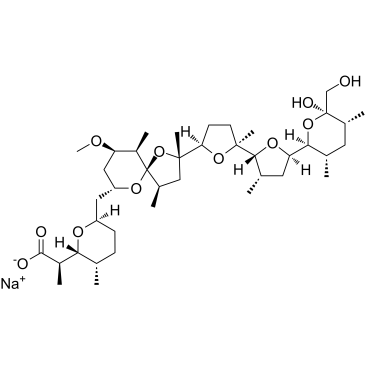| Cas No.: | 28643-80-3 |
| Chemical Name: | Nigericin sodium |
| Synonyms: | Sodium Nigericin;NSC-292567 |
| SMILES: | [Na+].O=C(C(C1[C@@H](C)CC[C@H](C[C@@H]2C[C@@H](OC)[C@@H](C)[C@]3(C(C)CC(C4CCC(C5O[C@@H]([C@@H]6[C@@H](C)C[C@@H](C)[C@](O)(CO)O6)C[C@@H]5C)(C)O4)(C)O3)O2)O1)C)[O-] |
| Formula: | C40H67NaO11 |
| M.Wt: | 764.955 |
| Sotrage: | 2 years -20°C Powder, 2 weeks4°C in DMSO,6 months-80°C in DMSO |
| Description: | Nigericin sodium salt is an antibiotic from Streptomyces hygroscopicus that works by acting as an H+, K+, and Pb2+ ionophore. |
| In Vivo: | Ngericin (4 mg/kg, i.p.) significantly reduces tumor growth and acts synergistically with the chemotherapeutic agent DDP, as shown by the tumor volumes. Nigericin markedly decreases Bmi-1 in vivo. Overexpression of Bmi-1 partially restores CSC content and metastatic ability of NPC cells under Nigericin treatment. The downregulation of Bmi-1 may be involved in the inhibitory effect of Nigericin on CSCs in NPC[3]. |
| In Vitro: | Nigericin (0.1 µM) decreases inhibits proliferation and clonogenicity of H460 lung cancer cells in a dose dependent manner. Nigericin inhibits migration and invasion of H460 lung cancer cells[1]. Nigericin (0.1-10 nM) has apparently a dual effect on cell volume, that is a shrinking effect at lower Nigericin concentrations and a swelling effect at higher concentrations. Nigericin (0.1-1 nM) significantly decreases cytosolic pH (pHi), and slightly increases the pHi at 5 and 10 nM[2]. Nigericin exhibits higher toxicity on S18 cells than S26 cells, with IC50 of 2.03±0.55 μM and 4.77±2.35 μM, respectively. Nigericin can selectively kill cancer stem cells in NPC in vitro. Nigericin dramatically reduces the migration ability of S18 and HONE-1 cells[3]. Nigericin exhibits gteat toxicity for the HT29 and SW116 cell line with IC50 of 12.92±0.25 μmol and 15.86±0.18 μmol. Nigericin also shows a decreased ability to form colonies under anchorage-independent conditions in a standard soft agar assay[4]. |

 To enhance service speed and avoid tariff delays, we've opened a US warehouse. All US orders ship directly from our US facility.
To enhance service speed and avoid tariff delays, we've opened a US warehouse. All US orders ship directly from our US facility.




















